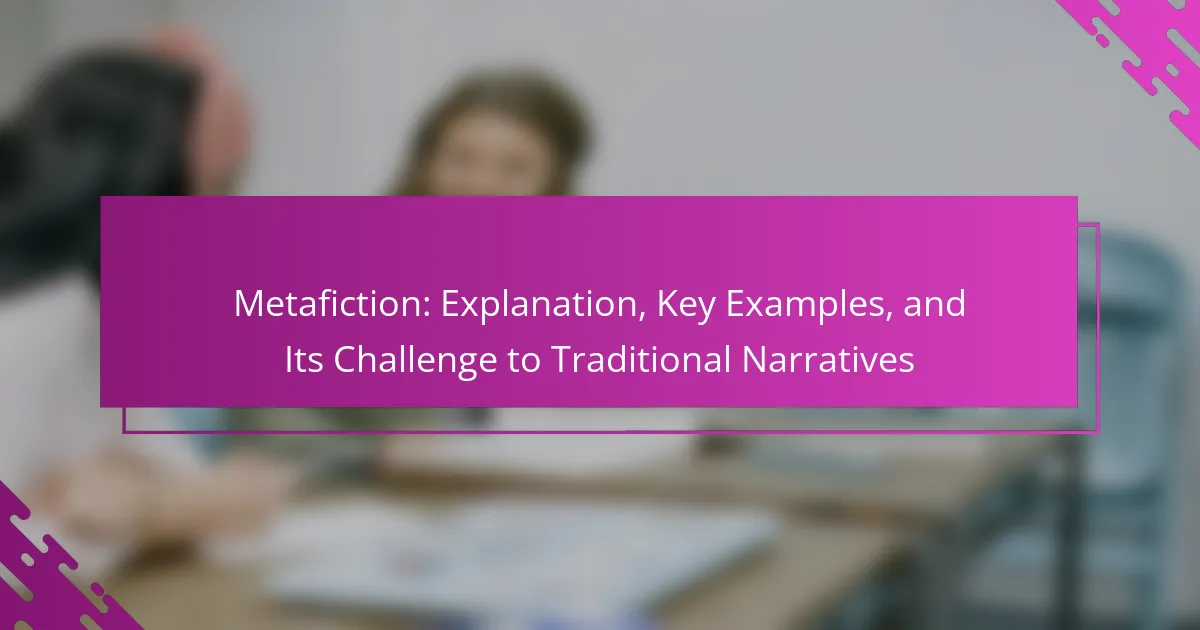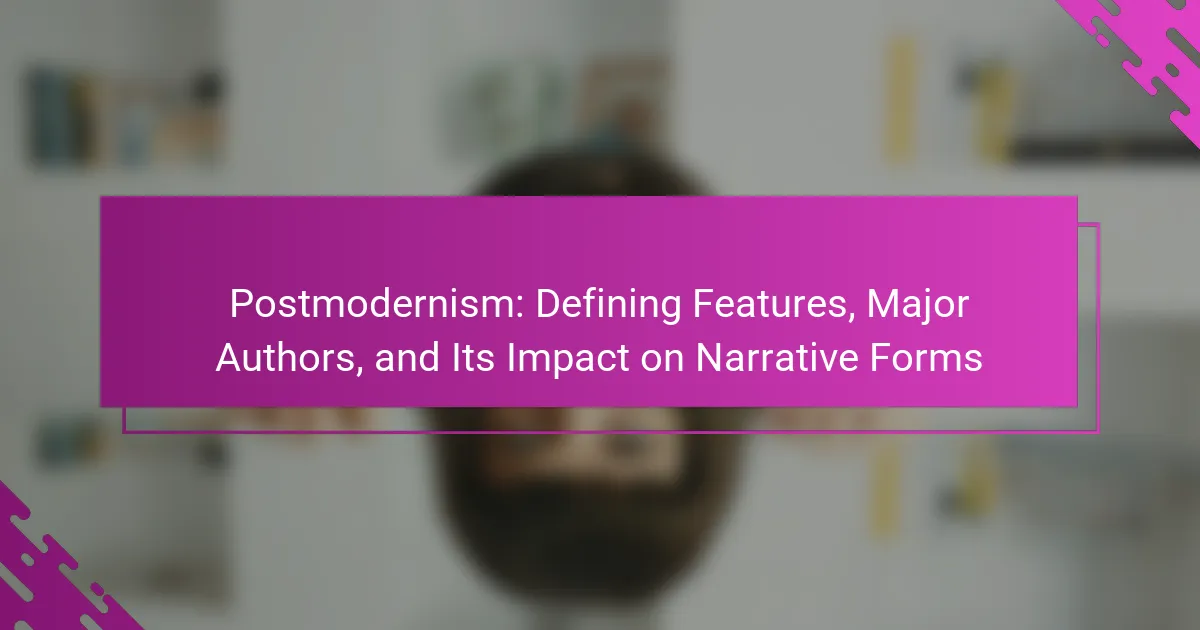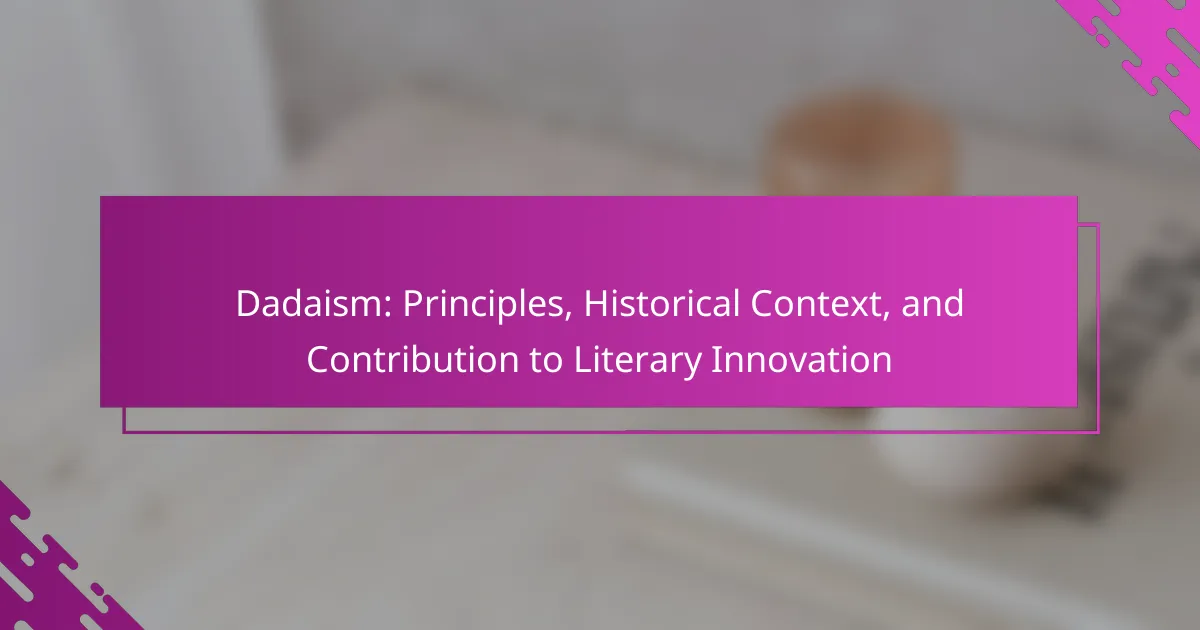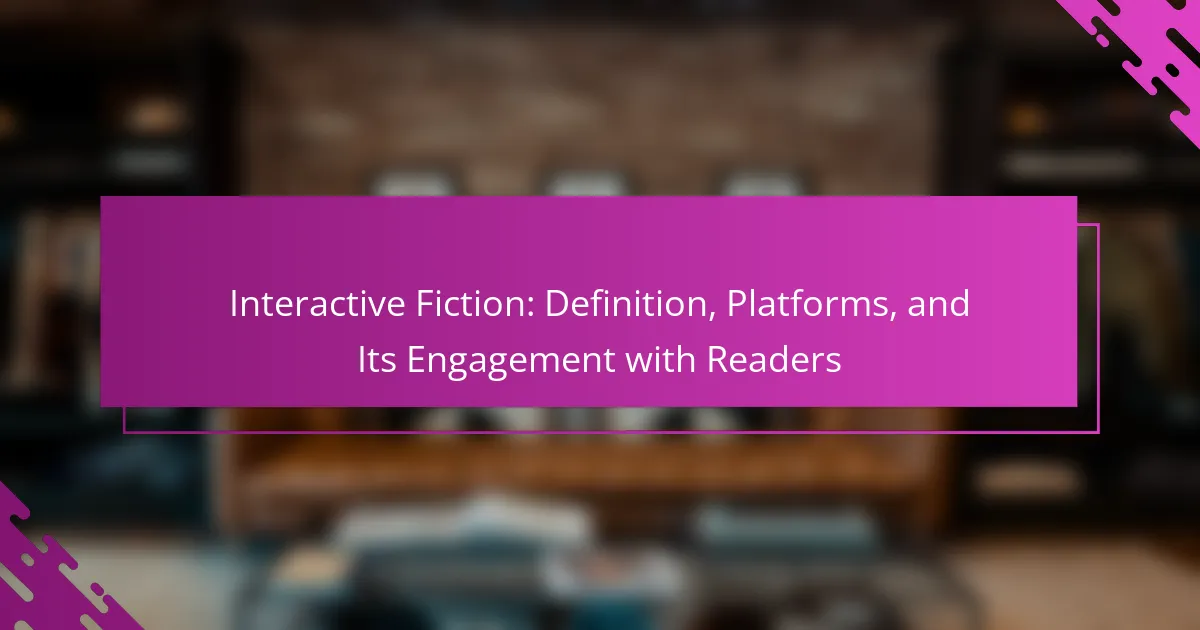Nonlinear narratives enhance storytelling by engaging audiences in unique ways. This article explores techniques like fragmented timelines and multiple perspectives, highlights notable examples from literature and film, examines cultural influences, and discusses potential pitfalls in crafting these narratives. Understanding these elements can deepen emotional connections and enrich the storytelling experience.

How do nonlinear narratives challenge traditional storytelling methods?
Nonlinear narratives challenge traditional storytelling by disrupting chronological flow and encouraging active audience engagement. They utilize techniques like fragmented timelines and multiple perspectives, creating a more immersive experience. For example, films like “Pulp Fiction” and novels like “Catch-22” exemplify this method, allowing viewers and readers to piece together the story uniquely. This approach fosters deeper emotional connections and invites interpretation, contrasting with linear narratives that often deliver a straightforward, passive experience.
What are the key characteristics of nonlinear narratives?
Nonlinear narratives feature unique structures that deviate from traditional linear storytelling. Key characteristics include fragmented timelines, multiple perspectives, and non-chronological sequences. These techniques create complexity and invite deeper engagement from the audience. For example, films like “Pulp Fiction” utilize disjointed timelines to enhance suspense and thematic depth. Additionally, nonlinear narratives often challenge conventional cause-and-effect relationships, allowing for richer character development and emotional resonance.
Why do authors choose nonlinear structures over linear ones?
Authors choose nonlinear structures to enhance complexity and engage readers in unique ways. Nonlinear narratives allow for multiple perspectives and timelines, creating a richer storytelling experience. This approach encourages active participation, as readers piece together the plot. Additionally, it can evoke emotions through unexpected revelations and shifts in time, making the narrative more impactful.
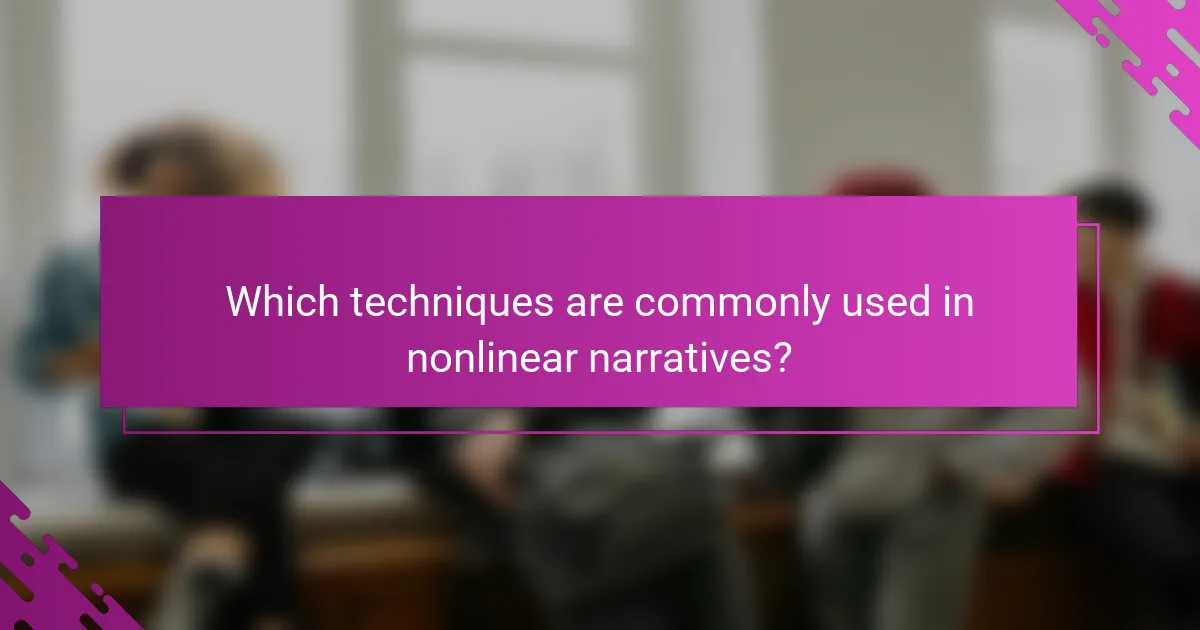
Which techniques are commonly used in nonlinear narratives?
Nonlinear narratives commonly use techniques such as fragmented timelines, multiple perspectives, and unreliable narrators. These methods enhance storytelling by creating suspense, encouraging active engagement, and allowing deeper character exploration. For example, a fragmented timeline can reveal crucial plot points out of sequence, while multiple perspectives provide varied insights into the same events.
How does time manipulation enhance narrative depth?
Time manipulation enhances narrative depth by allowing complex character development and thematic exploration. Nonlinear narratives create suspense and surprise, engaging the audience in unique ways. Techniques like flashbacks and foreshadowing enrich storytelling, revealing backstory and future implications simultaneously. This approach fosters a deeper emotional connection, as viewers piece together fragmented timelines, leading to a more immersive experience.
What role do multiple perspectives play in nonlinear storytelling?
Multiple perspectives enrich nonlinear storytelling by providing depth and complexity. They allow audiences to engage with the narrative from various angles, enhancing emotional resonance. This technique encourages active interpretation, as viewers piece together fragmented timelines and character arcs. Furthermore, it can reveal hidden motivations, creating a more immersive experience. Nonlinear narratives, such as those seen in films like “Pulp Fiction,” showcase how diverse viewpoints can transform a story’s impact and meaning.
How can flashbacks and flash-forwards be effectively utilized?
Flashbacks and flash-forwards can enhance storytelling by providing context and building suspense. They create emotional depth and reveal character motivations. Effective use involves strategic placement to maintain narrative flow and coherence. For instance, a flashback can explain a character’s current dilemma, while a flash-forward can foreshadow future events, creating intrigue. Balancing these techniques ensures they enrich the story without confusing the audience.
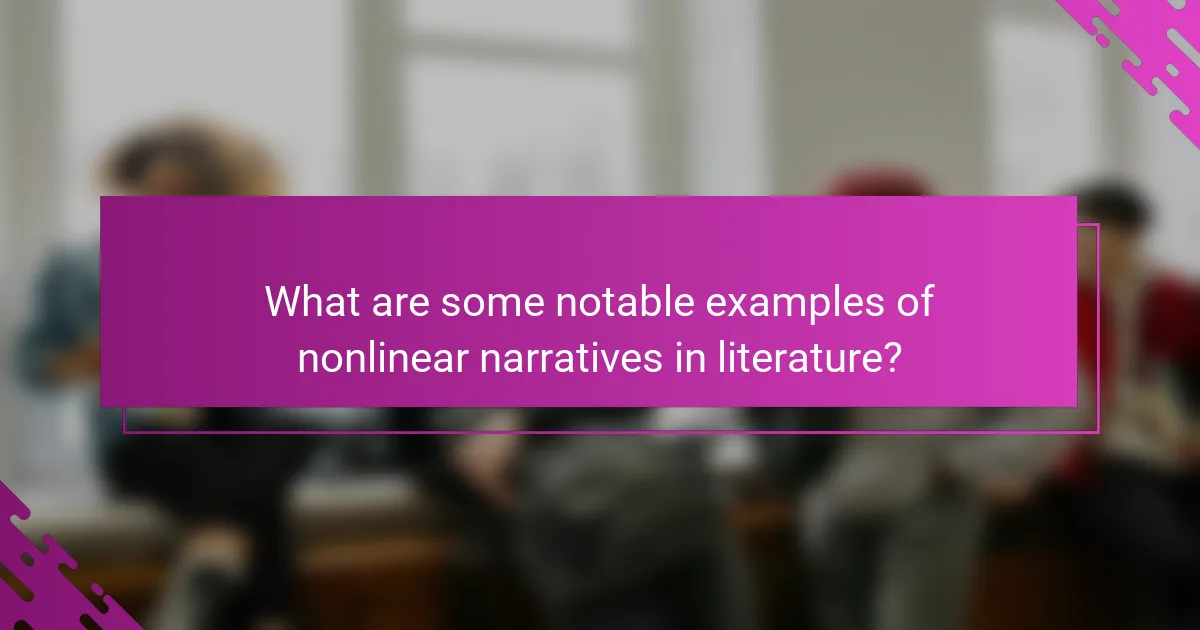
What are some notable examples of nonlinear narratives in literature?
Notable examples of nonlinear narratives in literature include “Catch-22” by Joseph Heller, “The Sound and the Fury” by William Faulkner, and “One Hundred Years of Solitude” by Gabriel García Márquez. These works employ techniques like fragmented timelines and multiple perspectives, enhancing complexity and reader engagement. For instance, “Catch-22” uses a circular structure that reflects the absurdity of war, while “The Sound and the Fury” showcases different viewpoints across time. These approaches challenge traditional storytelling, allowing deeper exploration of themes and character development.
How has ‘Catch-22’ influenced modern storytelling techniques?
‘Catch-22’ significantly shaped modern storytelling by popularizing nonlinear narratives. This technique disrupts chronological order, creating complexity and depth. For example, the fragmented structure encourages readers to piece together the plot, enhancing engagement. This method has influenced contemporary works like ‘The Sound and the Fury’ and ‘House of Leaves’, showcasing its lasting impact. Nonlinear narratives challenge traditional storytelling, inviting innovative approaches to plot and character development.
What impact did ‘The Sound and the Fury’ have on narrative structure?
‘The Sound and the Fury’ significantly influenced nonlinear narratives by employing multiple perspectives and time shifts. This technique reshaped storytelling, allowing for deeper character exploration and thematic complexity. The novel’s fragmented structure mirrors the chaotic nature of the characters’ lives, enhancing emotional engagement. As a result, it set a precedent for modern literature, inspiring authors to experiment with narrative forms.
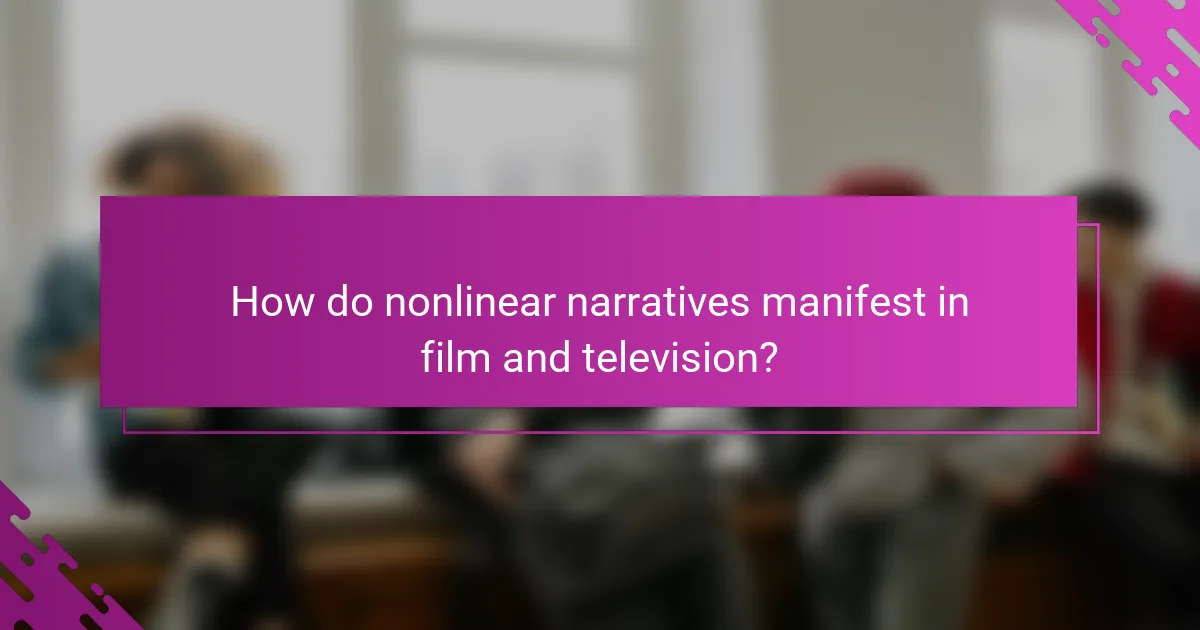
How do nonlinear narratives manifest in film and television?
Nonlinear narratives in film and television often use techniques like flashbacks, parallel storylines, and fragmented timelines. These methods create a complex viewing experience, engaging audiences by challenging traditional storytelling. For example, “Pulp Fiction” employs non-chronological order to intertwine multiple character arcs. As a result, viewers experience heightened suspense and emotional depth, making the narrative more immersive. This approach allows for unique character development and thematic exploration, showcasing the versatility of storytelling in visual media.
Which films exemplify the use of nonlinear storytelling?
Films that exemplify nonlinear storytelling include “Pulp Fiction,” “Memento,” and “Eternal Sunshine of the Spotless Mind.” These films disrupt chronological order to enhance emotional depth and viewer engagement. “Pulp Fiction” intertwines multiple narratives, creating a complex web of character interactions. “Memento” uses a reverse chronology, immersing viewers in the protagonist’s disorientation. “Eternal Sunshine of the Spotless Mind” employs fragmented memories, reflecting the chaotic nature of relationships. Each film demonstrates how nonlinear techniques can enrich storytelling and provoke thought.
What techniques do directors employ to maintain audience engagement?
Directors employ nonlinear narratives to enhance audience engagement by creating suspense, encouraging active participation, and deepening emotional connections. Techniques include flashbacks, parallel storylines, and fragmented timelines. These methods challenge viewers to piece together the narrative, maintaining interest and fostering discussion. For example, films like “Pulp Fiction” and “Memento” illustrate how nonlinear structures can create intrigue and surprise, enhancing the overall storytelling experience.
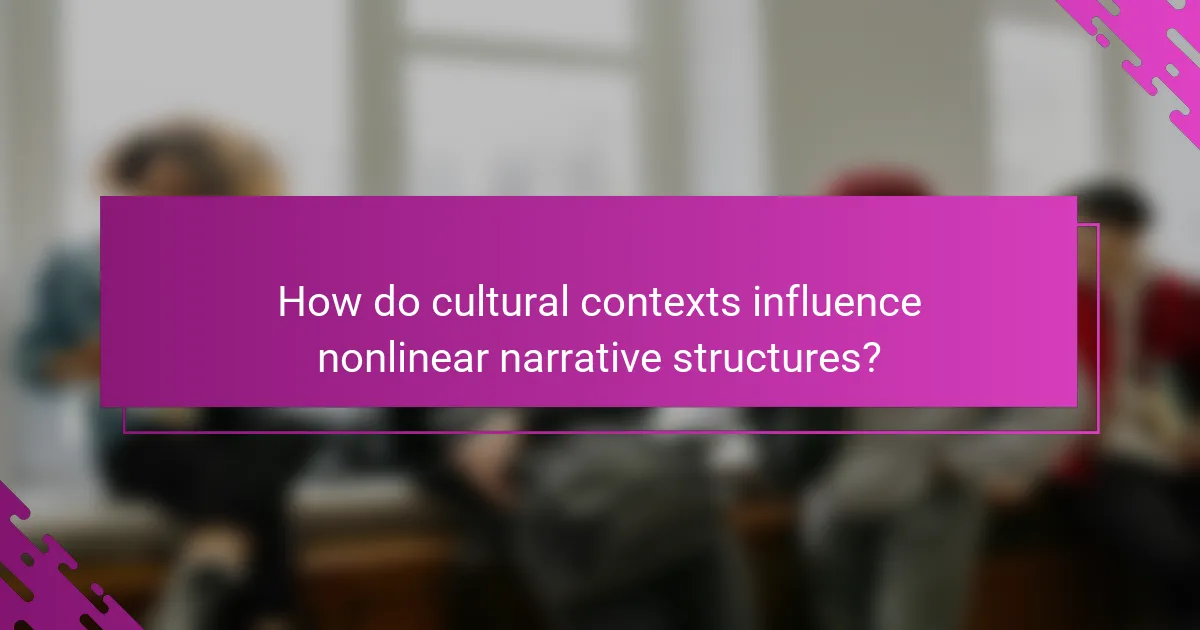
How do cultural contexts influence nonlinear narrative structures?
Cultural contexts significantly shape nonlinear narrative structures by influencing themes, character development, and audience engagement. Different cultures prioritize distinct storytelling techniques, affecting how stories unfold and resonate. For instance, in some cultures, circular narratives reflect a belief in cyclical time, while others may embrace fragmented timelines to mirror complex realities. These variations enhance the emotional depth and relatability of narratives, allowing for diverse interpretations. Ultimately, cultural contexts inform the choices authors make in structuring their stories, enriching the storytelling landscape.
What variations exist in nonlinear narratives across different cultures?
Nonlinear narratives vary significantly across cultures, reflecting distinct storytelling traditions. For example, Japanese literature often employs circular narratives, while Western narratives may use fragmented timelines. Indigenous storytelling frequently integrates oral traditions, allowing for multiple perspectives. These variations enhance emotional engagement and cultural resonance, demonstrating the unique attributes of each storytelling approach.
How do audience expectations differ based on cultural backgrounds?
Audience expectations vary significantly based on cultural backgrounds, influencing their reception of nonlinear narratives. Different cultures prioritize distinct storytelling elements, such as character development, plot structure, and thematic depth.
In cultures with a linear storytelling tradition, audiences may struggle with nonlinear techniques, finding them confusing. Conversely, cultures that embrace circular or fragmented narratives often appreciate the complexity and depth nonlinear storytelling offers.
For example, Japanese narratives frequently utilize nonlinear structures, allowing audiences to engage with the story on multiple levels. In contrast, Western audiences may prefer more straightforward narratives that follow a clear progression.
Understanding these cultural nuances helps storytellers craft narratives that resonate with diverse audiences, enhancing engagement and emotional impact.
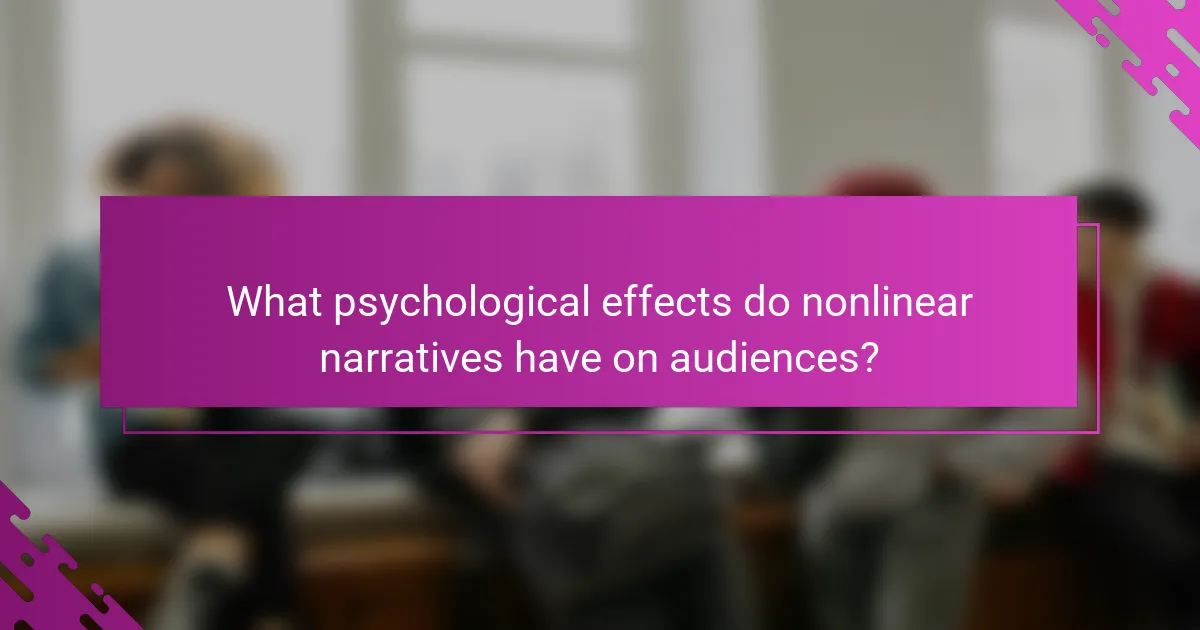
What psychological effects do nonlinear narratives have on audiences?
Nonlinear narratives can evoke strong psychological effects on audiences, including heightened engagement and emotional response. These narratives challenge traditional storytelling, creating intrigue and stimulating cognitive processing. Audiences often experience a sense of discovery as they piece together fragmented timelines. This format can also enhance empathy by allowing viewers to see multiple perspectives. Additionally, nonlinear structures can lead to a deeper understanding of themes and character motivations, fostering a more immersive experience.
How does audience engagement change with nonlinear storytelling?
Audience engagement increases with nonlinear storytelling due to its immersive and interactive nature. This approach allows audiences to experience narratives in a more personalized manner.
Nonlinear narratives often utilize techniques like flashbacks, parallel plots, and fragmented timelines. These elements encourage deeper emotional connections and provoke curiosity. As a result, audiences actively participate in piecing together the story, enhancing their overall engagement.
For instance, films like “Pulp Fiction” and “Eternal Sunshine of the Spotless Mind” exemplify nonlinear storytelling. They invite viewers to engage with the narrative structure, making the experience more dynamic and memorable.
Furthermore, the unpredictability of nonlinear storytelling can lead to increased discussion and analysis among audiences. This shared experience fosters community engagement, as viewers share interpretations and insights, further enriching the narrative’s impact.
What cognitive processes are activated by nonlinear narratives?
Nonlinear narratives activate cognitive processes such as memory retrieval, emotional engagement, and critical thinking. These narratives challenge traditional storytelling by presenting events out of chronological order, prompting readers to actively piece together the plot. This engagement enhances comprehension and retention, making the experience more immersive. Additionally, nonlinear structures can evoke curiosity and surprise, as readers navigate unexpected twists and turns.
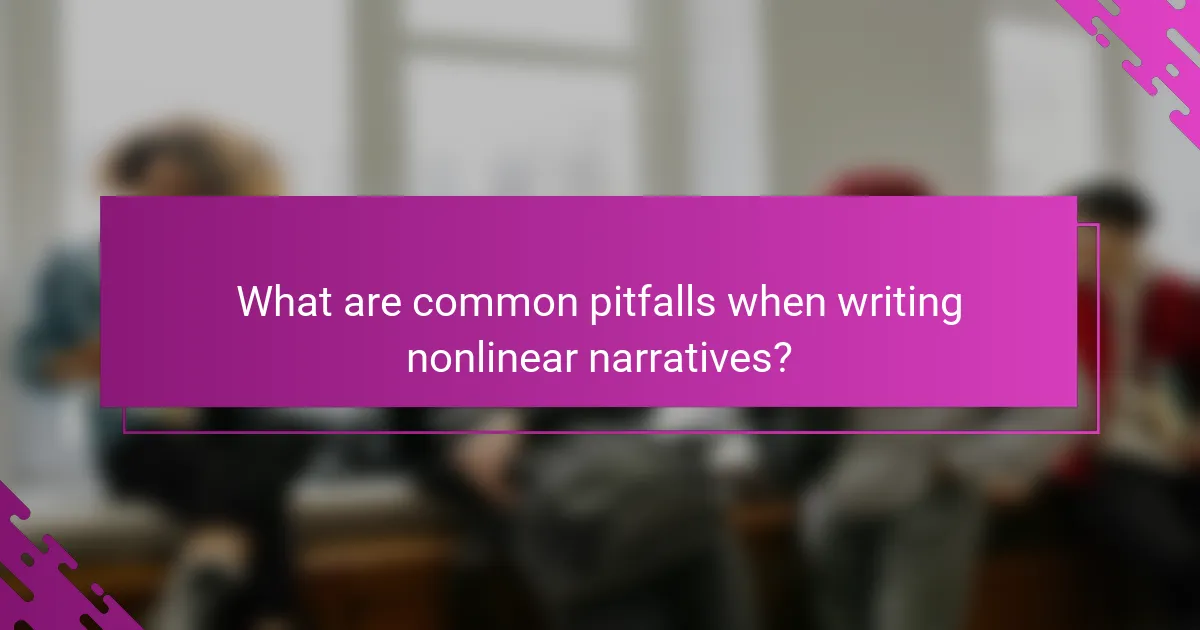
What are common pitfalls when writing nonlinear narratives?
Common pitfalls when writing nonlinear narratives include confusing timelines, lack of character development, and inadequate thematic coherence. These issues can lead to reader disorientation and disengagement.
Confusing timelines often arise from excessive jumps between past and present without clear transitions. This can make it difficult for readers to follow the story.
Lack of character development can result in characters feeling flat or unrelatable. When narratives do not build emotional connections, readers may struggle to invest in the story.
Inadequate thematic coherence can dilute the overall message. When themes are not consistently reinforced, the narrative risks losing its impact and clarity.
How can authors avoid confusing their audience?
Authors can avoid confusing their audience by maintaining clarity and coherence in nonlinear narratives. To achieve this, they should consider the following techniques:
1. Establish a clear structure: Use distinct segments or chapters to indicate shifts in time or perspective.
2. Provide context clues: Include reminders of previous events or character motivations to orient the reader.
3. Limit complexity: Avoid excessive plotlines or characters that can overwhelm the audience.
4. Use consistent themes: Reinforce central themes to create a cohesive narrative experience.
These techniques enhance audience understanding and engagement while navigating nonlinear storytelling.
What strategies can enhance clarity in complex narratives?
Nonlinear narratives can enhance clarity through strategic techniques such as foreshadowing, character perspectives, and thematic anchors. These methods help readers navigate complex storylines effectively.
1. Use foreshadowing to provide hints about future events, guiding reader expectations.
2. Implement multiple character perspectives to offer diverse insights and deepen understanding.
3. Establish thematic anchors that connect disparate plot points, creating coherence.
4. Employ visual aids like timelines or maps to illustrate narrative structure and relationships.
What best practices should writers follow when crafting nonlinear stories?
Writers crafting nonlinear stories should prioritize clarity, structure, and emotional engagement. Effective techniques include using flashbacks, alternating timelines, and multiple perspectives to enhance complexity. Each technique should serve the narrative’s emotional core, maintaining audience connection. Additionally, writers must ensure that transitions between sections are seamless to avoid confusing readers. Engaging the audience through suspense and revelation can also amplify impact, making the story memorable.
